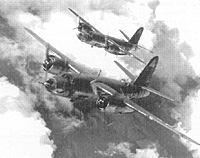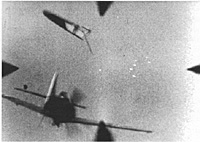
To fight against 20 Russians that want to have a bite of one, or also against Spitfires is a joy. But the curve into 70 Fortresses lets all the sins of one's life pass before one's eyes.
- --Hauptmann Hans Philipp, 206 victories
According to experience, it took 20 to 25 hits with 20mm shells to shoot down a Flying Fortress.--Lt.-Gen. Adolf Galland, 104 victories
With Over The Reich (Clash of Arms, 1993) and Achtung-Spitfire! (Clash of Arms, 1994) of the Fighting Wings system, the state of the art of World War II air combat games takes a quantum leap. This system owes much to designer J. D. Webster's own experience as a pilot and to his prior designs, Air Superiority (GDW, 1987), Air Strike (GDW, 1987) and The Speed of Heat (Clash of Arms, 1992). The Fighting Wings combat system is sophisticated and complex, imparting a distinct sense of realism.
Interestingly enough, Fighting Wings uses that most venerable of CRTs, the old and familiar odds-based table. This is unusual in that odds-based tables are far more typical for operational or strategic land combat simulations, and less typical for close tactical games of any sort, let alone an air combat game system as detailed and complex as Fighting Wings. Nevertheless, Webster has fashioned a very workable system.
With the odds-based table, the firepower of the attacker is divided by the defense factor of the target. In addition, each aircraft can survive a certain number of hit points before being severely damaged or destroyed. A severely damaged aircraft has simply reached a point where its structural integrity has been badly compromised, prohibiting radical maneuvers or drastic changes in altitude.
The odds-based CRT makes certain aircraft not only harder to destroy; it also makes them harder to damage. For example, the rugged B-17G can take 17/26 hits (severe damage/destroyed); it also has a defense value of 7. By contrast, the FW-190A8 can only take 11/17 hits, and has a 5 defense value. Target attitude, pilot experience, firer's speed, and a myriad other factors in air combat are all taken into consideration, either conferring a column shift or a die roll modifier.
In addition, Webster's rating of each weapon, while similar to the Air Force method, now takes into consideration the power of the projectile. First, each weapon is rated for its firepower, influenced by range. Therefore, a .303 caliber machine gun has 13 firepower factors at point blank range (zero hexes), dropping off to 2 FP at its maximum range of 5 hexes.
Next, Webster takes the critical hit concept further and in some very interesting ways. Each weapon is rated for a critical hit value. For example, a 20 mm cannon has a critical hit rating of 2 while a rifle-caliber machine gun has a rating of 4. This means for every two hits inflicted by the cannon, a critical hit may occur, while it takes four hits from the machine gun to possibly inflict a critical. Therefore, Webster's combat system takes into account range attenuation and the killing power of heavy armaments. A quick comparison of the weapons below shows the difference in weight of fire of these armaments:
- .303 inch Browning rate of fire: 1,200 rpm Projectile weight: 0.344 oz.
20 mm MG FF rate of fire: 520 rpm Projectile weight: 4.82 oz.
7.92 mm MG 17 rate of fire: 1,100 rpm Projectile weight: 0.45 oz.
Webster reasons that weapons with high rate of fire will produce a higher number of hits, causing mostly structural damage, while a powerful cannon, albeit with a lower rate of fire, inflicts fewer but more lethal hits. In Fighting Wings, as in historical air combat, aircraft can be chopped to bits through numerous non-lethal hits but more likely, they are brought down by critical hits to vulnerable components well before the aircraft is completely chewed up by gun fire.
Webster also takes the variety of critical hits to new heights. Critical hits can affect the engine, fuel tanks, cockpit, wings, equipment or flight controls. Within each component, there are a variety of effects; for example, an engine hit can start a fire, while an equipment hit can cause the loss of gun synchronization. The results are as imaginative as they are comprehensive. Now, the results of historical dogfights can be simulated with a vivid sense of realism.
Webster also continues the design trend of including detailed pilot characteristics. In addition to experience and training, pilots can now have up to five characteristics, such as keen eyes (spotting modifier) and hero (allowing an initiative modifier for other pilots). With these rules, Fighting Wings brings to "life" the likes of the deadly Al Deere (veteran-ace-crack shot), the indomitable and inspirational Douglas Bader (veteran-ace-hero), the calculating and daring Adolf Galland (veteran-ace-hero-crack shot), and the virtuoso Hans Joachim Marseille (veteran-ace-crack shotgifted).
Lastly, the Fighting Wings system takes into consideration a pair of related factors not covered by any other game: pilot morale in attacking head-on and collisions due to a misjudged head-on attack. To attack an enemy aircraft head-on requires the pilot to pass a die roll, modified by his experience, size of the aircraft, closing speed of the aircraft, etc. Passing the roll allows an attack, and if the attack is carried out within a critical distance, the player must roll for possible collision. This rule imparts a sense of how difficult it must have been to tackle a behemoth like the B-17. There is a fine life-and-death balance between going in closer for a good hit and risking a mid-air collision.
Therefore, with the Fighting Wings system, an FW-190A8 firing at a B-17G head-on at one-hex range does so at 6:1 odds. It would obtain anywhere from 12 to 4 hits, with a 10% chance of missing altogether. More important, with a critical rating of 2 for its cannon, the FW 190 will obtain at least two critical hits on its target. In addition, an attack from 12 o'clock tends to concentrate the critical hits in the vulnerable engines, fuel tank and pilot compartment. A total of three die rolls must be made on three separate tables -- the combat odds ratio, the aircraft area hit table and one of the various critical hit tables -- to answer hit probability, hit total, hit location and hit effect. All in all, combat is comprehensive, authentic, and would satisfy any garner with a particular interest in historical aviation combat. The weaknesses of the Air Force system mentioned previously are all addressed in Fighting Wings.
 Two other air combat games designed in the 1990s deserve a mention. Dan Verssen's Down in Flames series (Rise of the Luftwaffe, GMT Games, 1993; Eighth Air Force, GMT Games, 1995) cover the same arena but in a card game format. The results of combat bear little resemblance to reality but certainly work well within the design parameters (playability and simplicity over detail, with a card-driven, CRT-less combat system.) Combat basically consists of playing an attack card, which can be countered by a defensive maneuver card.
Two other air combat games designed in the 1990s deserve a mention. Dan Verssen's Down in Flames series (Rise of the Luftwaffe, GMT Games, 1993; Eighth Air Force, GMT Games, 1995) cover the same arena but in a card game format. The results of combat bear little resemblance to reality but certainly work well within the design parameters (playability and simplicity over detail, with a card-driven, CRT-less combat system.) Combat basically consists of playing an attack card, which can be countered by a defensive maneuver card.
Craig Taylor's Mustangs (TAHGC, 1992), derived from his Air Force system shares the Down in Flames design parameters and limitations, but in a board game format. It, too, features a CRT-less combat system. To obtain strikes on a target the attacker rolls a die, adding his firepower, while the defender rolls a die but adds his aircraft's defense modifier. Mustangs, however, bears the distinction of being the only game among those surveyed that addresses the issue of target fixation. In the game, a pilot may spot multiple aircraft, and needs to spot a target before he can open fire at it; however, once he opens fire on his target, he automatically loses his spotting of all other enemy aircraft. He will need to visually acquire the other aircraft all over again. In addition, if a pilot is attacked by an unspotted enemy pilot, he suffers a significant detrimental modifier-in other words, he has been "bounced." In this way, the game rules encourage the historical use of wingmen to keep an eye out for other enemy pilots while their leads are padlocked and closing in on their quarries.
In addition to their CRT-less combat resolution systems, both Down in Flames and Mustangs are notable for the fact the all aircraft information are on the playing pieces themselves-neither game uses aircraft data cards-another nod toward simplicity and playability.
CONCLUSION
As can be seen in the evolution of the design of close tactical air combat games, early games tended to focus more on hardware issues-how fast, how high, how powerful. Later games have paid more attention to the human element-how skilled, how accurate, how experienced. Even the simple Down in Flames has rules to simulate the difference in pilot quality. Fighting Wings has a most interesting rule that allows wingmen to use the initiative of the formation leader; a simple rule that probably simulates the extent of command-control a leader can exercise in the melee of a dogfight. Thus, there has been a movement toward adding a little role-playing element to air combat games.
The combat systems, by and large, have become more realistic, even in some of the simpler games. The effects of damage have now been simulated with much more satisfying results. Instead of the rudimentary "hit," damage effects in the later games mirror history more accurately. The design of air combat games has thus far reached the state of the art with the Fighting Wings series, capping off the trend toward more and more complex designs. Yet the 1990s have also seen the return to simpler combat systems, such as the Down in Flames series and Mustangs. Thus, it would appear that the design of air combat games has come full circle: like early games, some of the latest games have focused more on simplicity and playability. Ultimately, the accuracy and complexity of a combat system depends on the designer's intent: to provide intricate and detailed rules for the air combat enthusiast or to cater to the casual gamer eschewing the weight of minutiae. Regardless of expertise, knowledge or experience, garners share the same desire: to experience the thrill of air combat without any unpleasant side effects.
There is nothing more exhilarating than to be shot at without result.
- --Winston Churchill
Tactical Level Air Combat A Survey of Combat Resolution Systems
- Introduction
First Generation Systems
Second Generation Systems
Third Generation Systems and Conclusion
Back to Table of Contents -- Against the Odds vol. 2 no. 2
Back to Against the Odds List of Issues
Back to MagWeb Magazine List
© Copyright 2003 by LPS.
This article appears in MagWeb.com (Magazine Web) on the Internet World Wide Web.
Other articles from military history and related magazines are available at http://www.magweb.com
* Buy this back issue or subscribe to Against the Odds direct from LPS.
